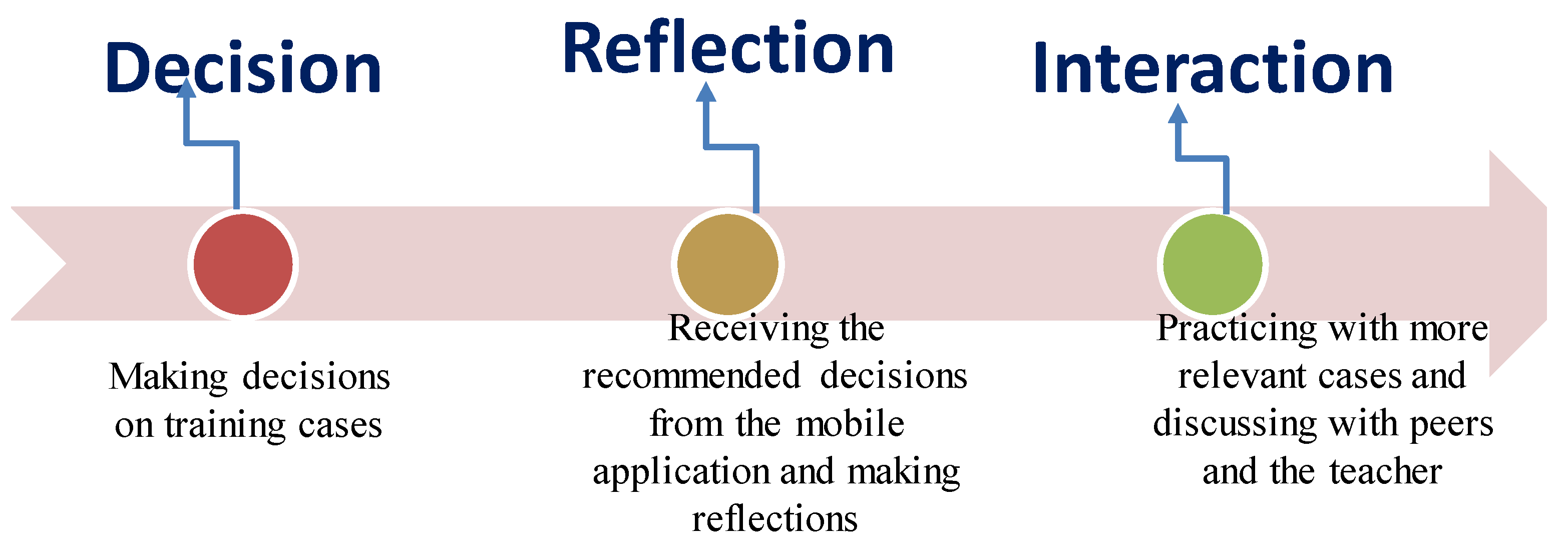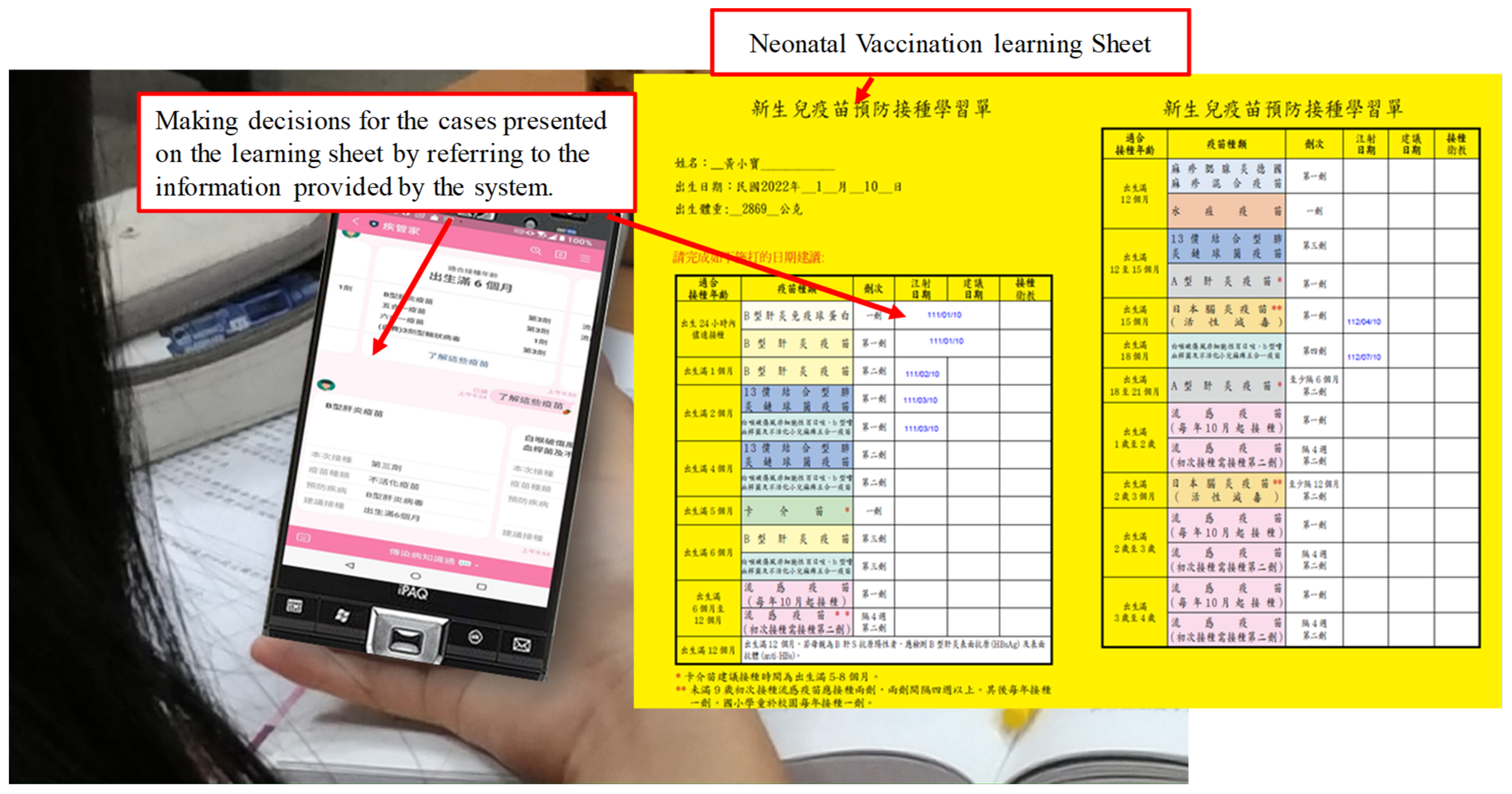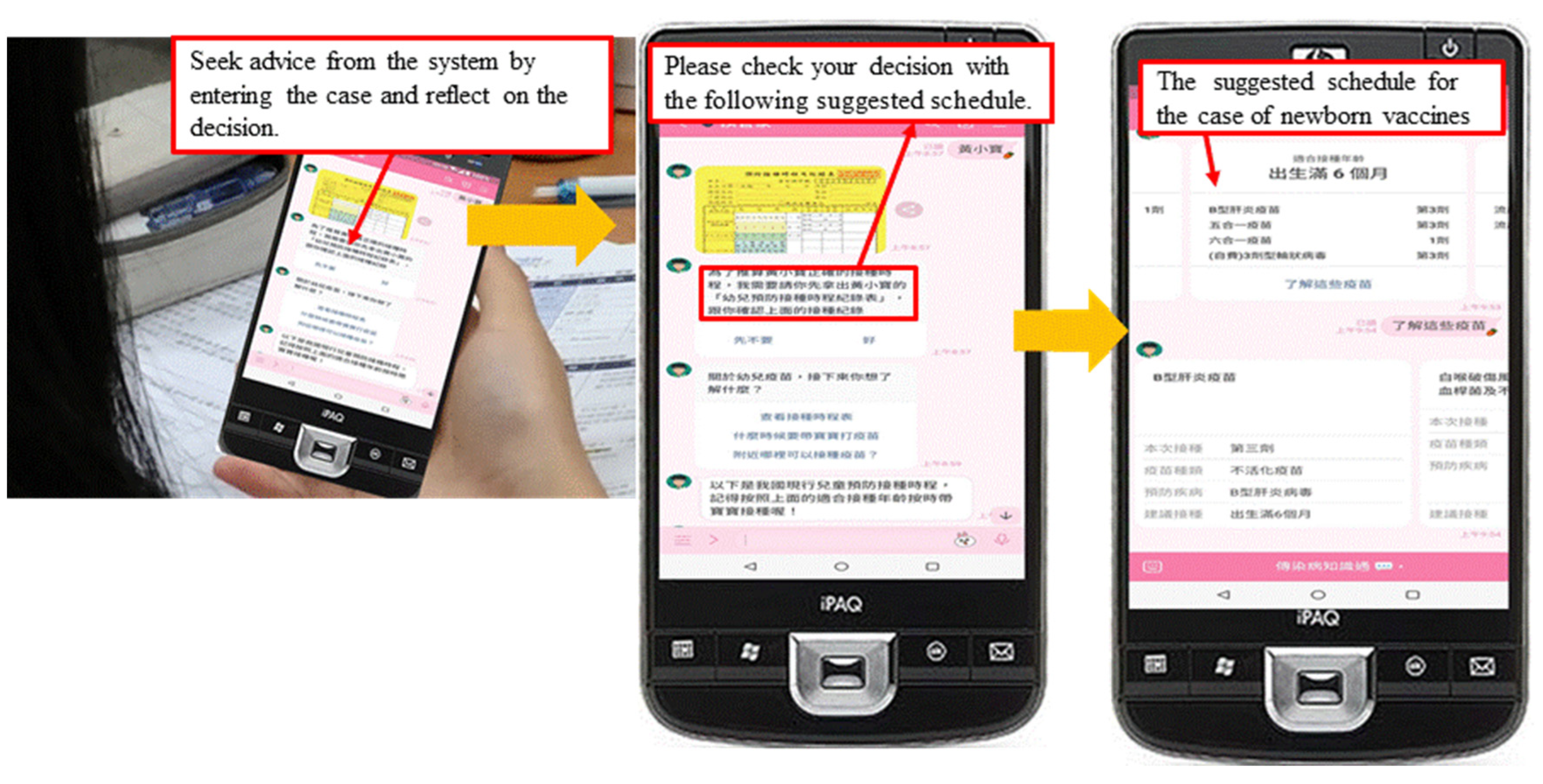Effects of a Technology-Supported Decision, Reflection, and Interaction Approach on Nursing Students’ Learning Achievement and Self-Efficacy in Professional Training: A Pilot Study
Abstract
1. Introduction
- (1)
- What are students’ learning experiences with the DRI-based mobile professional training approach compared with conventional technology-assisted teaching?
- (2)
- Compared with conventional technology-assisted teaching, can the DRI-based mobile professional training approach promote students’ learning achievement in a course on neonatal vaccination knowledge?
- (3)
- Compared with conventional technology-assisted teaching, can the DRI-based mobile professional training approach improve students’ self-efficacy in a course on neonatal vaccination knowledge?
2. Literature Review
3. Decision, Reflection, and Interaction (DRI)-Based Professional Training Model
4. Materials and Methods
4.1. Method
4.2. Participants
4.3. Experimental Process
4.4. Measurement Tools
5. Results
5.1. Interviews
- (1)
- Interview results of the experimental group
- (2)
- Interview results of the control group
5.2. Learning Achievement
5.3. Self-Efficacy
6. Discussion
7. Limitations and Future Directions
- (1)
- When studying DRI-based professional training, personal factors such as individual students’ preferences or self-efficacy might also affect the training outcomes. Taking these factors into account could further improve trainees’ performance. Therefore, it is suggested that researchers take personal factors into account when designing their future studies.
- (2)
- The effectiveness of DRI-based professional training can be further explored from different angles. For example, in the application of neonatal vaccination, up-to-date information (e.g., regarding the COVID-19 pandemic) can be added to the learning content of the training program to enable the trainees to link what they have learned to practical clinical situations.
- (3)
- The use of an expert system as part of the learning method has good potential for inspiring students to think deeply, increasing their critical thinking, enhancing their reflective ability, promoting their professional capacity to deal with problems related to neonatal vaccination for mothers and families in their future workplaces, and promoting their willingness to further actively explore the relevant knowledge. Therefore, it is suggested that researchers investigate the diverse effects of the approach on trainees’ performance.
- (4)
- The DRI-based professional training can be applied to other medical professional training courses or even other professional training programs to explore trainees’ decision-making and problem-solving performance in different application contexts.
8. Conclusions
Author Contributions
Funding
Institutional Review Board Statement
Informed Consent Statement
Data Availability Statement
Acknowledgments
Conflicts of Interest
References
- Baker, Z. The vocational/academic divide in widening participation: The higher education decision making of further education students. J. Furth High. Educ. 2020, 44, 766–780. [Google Scholar] [CrossRef]
- Martin Aispuro, P.; Ambrosis, N.; Zurita, M.E.; Gaillard, M.E.; Bottero, D.; Hozbor, D.F. Use of a neonatal-mouse model to characterize vaccines and strategies for overcoming the high susceptibility and severity of pertussis in early life. Front. Microbiol. 2020, 11, 723. [Google Scholar] [CrossRef] [PubMed]
- Więckowska, A.; Królak-Olejnik, B. Impact of refusal to vaccine in the neonatal period on the implementation of the vaccination calendar in the first year of life. Hum. Vaccines Immunother. 2020, 17, 1156–1161. [Google Scholar] [CrossRef] [PubMed]
- Lee, J.T.; Lin, J.W.; Chen, H.M.; Wang, C.Y.; Lu, C.Y.; Chang, L.Y.; Huang, L.M. Impact of pneumococcal conjugate vaccination on hospitalized childhood pneumonia in Taiwan. Pediatr. Res. 2022, 92, 1161–1167. [Google Scholar] [CrossRef] [PubMed]
- Celikkalp, U.; Irmak, A.Y. Occupational exposures during clinical practice of candidate health professionals: Needlestick injuries and occupational knowledge levels. Int. J. Caring Sci. 2021, 14, 695. [Google Scholar]
- Grund, C.K.; Tulis, M. Facilitating student autonomy in large-scale lectures with audience response systems. ETRD-Educ. Tech. Res. Dev. 2020, 68, 975–993. [Google Scholar] [CrossRef]
- Orooji, F.; Taghiyareh, F. Enhancing students’ knowledge building through utilising social interactions in an online learning environment. New Rev. Hypermedia Multimed. 2018, 24, 307–334. [Google Scholar] [CrossRef]
- Bohlouli, M.; Mittas, N.; Kakarontzas, G.; Theodosiou, T.; Angelis, L.; Fathi, M. Competence assessment as an expert system for human resource management: A mathematical approach. Expert Syst. Appl. 2017, 70, 83–102. [Google Scholar] [CrossRef]
- Lee, C.A.; Tzeng, J.W.; Huang, N.F.; Su, Y.S. Prediction of student performance in massive open online courses using deep learning system based on learning behaviors. Educ. Technol. Soc. 2021, 24, 130–146. [Google Scholar]
- Stella, N.N.; Madhu, B.K. Expert system as tools for efficient teaching and learning process in educational system in Nigeria, first step. Int. J. Future Revolut. Comput. Sci. Comun. Eng. 2017, 3, 165–168. [Google Scholar]
- Oh, E.Y.; Song, D. Developmental research on an interactive application for language speaking practice using speech recognition technology. ETRD Educ. Tech. Res. Dev. 2021, 69, 861–884. [Google Scholar] [CrossRef]
- Al-Ghamdi, A.; Al Harbi, D.; Alarfaj, N.; Al Hajri, A.; Almarashdeh, I.; Alsmadi, M.; Alrajhi, D. Developing and implementing a web-based platform for skills and knowledge exchange. Int. J. Sci. Res. Sci. Technol. 2019, 6, 562–573. [Google Scholar] [CrossRef]
- Chen, B.; Wang, Y.; Xiao, L.; Xu, C.; Shen, Y.; Qin, Q.; Sun, Z. Effects of mobile learning for nursing students in clinical education: A meta-analysis. Nurse Educ. Today 2021, 97, 104706. [Google Scholar] [CrossRef] [PubMed]
- Chumachenko, D.; Chumachenko, K.; Yakovlev, S. Intelligent simulation of network worm propagation using the code red as an example. Telecommun. Radio Eng. 2019, 78, 443–463. [Google Scholar] [CrossRef]
- Yang, S.J.; Ogata, H.; Matsui, T.; Chen, N.S. Human-centered artificial intelligence in education: Seeing the invisible through the visible. Comput. Educ. Artif. Intell. 2021, 2, 100008. [Google Scholar] [CrossRef]
- Imam, M.H.; Tasadduq, I.A.; Ahmad, A.R.; Aldosari, F.; Khan, H. Automated generation of course improvement plans using expert system. Int. J. Qual. Assur. Eng. Technol. Educ. 2017, 6, 1–12. [Google Scholar] [CrossRef]
- Beydoun, G. Formal concept analysis for an e-learning semantic web. Expert Syst. Appl. 2009, 36, 10952–10961. [Google Scholar] [CrossRef]
- Martinez-Tenor, A.; Fernández-Madrigal, J.A.; Cruz-Martín, A.; González-Jiménez, J. Towards a common implementation of reinforcement learning for multiple robotic tasks. Expert Syst. Appl. 2018, 100, 246–259. [Google Scholar] [CrossRef]
- Tang, K.Y.; Chang, C.Y.; Hwang, G.J. Trends in artificial intelligence-supported e-learning: A systematic review and co-citation network analysis (1998–2019). Interact. Learn. Environ. 2021. [Google Scholar] [CrossRef]
- Lu, H.; Li, Y.; Chen, M.; Kim, H.; Serikawa, S. Brain intelligence: Go beyond artificial intelligence. Mob. Netw. Appl. 2018, 23, 368–375. [Google Scholar] [CrossRef]
- Hwang, G.J.; Sung, H.Y.; Chang, S.C.; Huang, X.C. A fuzzy expert system-based adaptive learning approach to improving students’ learning performances by considering affective and cognitive factors. Comput. Educ. Artif. Intell. 2020, 1, 100003. [Google Scholar] [CrossRef]
- Wagner, W.P. Trends in expert system development: A longitudinal content analysis of over thirty years of expert system case studies. Expert Syst. Appl. 2017, 76, 85–96. [Google Scholar] [CrossRef]
- Zhang, Y.; Chen, H.; Lu, J.; Zhang, G. Detecting and predicting the topic change of Knowledge-based Systems: A topic-based bibliometric analysis from 1991 to 2016. Knowl. Based Syst. 2017, 133, 255–268. [Google Scholar] [CrossRef]
- Yulianto, T.; Andryana, S.; Gunaryati, A. Expert System for Autism Prediction in Children with Web-Based Forward Chaining Method: Expert System for Autism Prediction in Children with Web-Based Forward Chaining Method. J. Mantik. 2020, 3, 522–530. Available online: http://iocscience.org/ejournal/index.php/mantik/article/view/606 (accessed on 19 February 2023).
- Crowe, D.; LaPierre, M.; Kebritchi, M. Knowledge based artificial augmentation intelligence technology: Next step in academic instructional tools for distance learning. Techtrends 2017, 61, 494–506. [Google Scholar] [CrossRef]
- Tarus, J.K.; Niu, Z.; Mustafa, G. Knowledge-based recommendation: A review of ontology-based recommender systems for e-learning. Artif. Intell. Rev. 2018, 50, 21–48. [Google Scholar] [CrossRef]
- Supriyadi, S.; Wiliyanto, D.A. Developing expert system application to identify specific children learning disabilities in inclusion schools. J. ICSAR 2021, 5, 38–41. [Google Scholar]
- Goksu, I. The evaluation of the cognitive learning process of the renewed bloom taxonomy using a web based expert system. Turk. Online J. Educ. Technol. 2016, 15, 135–151. [Google Scholar]
- Wanyan, Y.; Chen, X.; Olowokere, D. Integration of artificial intelligence methodologies and algorithms into the civil engineering curriculum using knowledge-based expert systems: A case study. Eng. Educ. Lett. 2017, 2017, 3. [Google Scholar] [CrossRef]
- López-Úbeda, P.; Díaz-Galiano, M.C.; Noguerol, T.M.; Ureña-López, A.; Martín-Valdivia, M.T.; Luna, A. Detection of unexpected findings in radiology reports: A comparative study of machine learning approaches. Expert Syst. Appl. 2020, 160, 113647. [Google Scholar] [CrossRef]
- Banjar, H.R.; Alkhatabi, H.; Alganmi, N.; Almouhana, G.I. Prototype development of an expert system of computerized clinical guidelines for COVID-19 diagnosis and management in Saudi Arabia. Int. J. Environ. Res. Public Health 2020, 17, 8066. [Google Scholar] [CrossRef] [PubMed]
- Jamil, M.N.; Hossain, M.S.; Islam, R.U.; Andersson, K. Technological Innovation capability evaluation of high-tech firms using conjunctive and disjunctive belief rule-based expert system: A comparative study. J. Wirel. Mobile Netw. Ubiquitous Comput. Dependable Appl. 2020, 11, 29–49. [Google Scholar] [CrossRef]
- Anwar, M. Designing an expert system for determining student learning styles using forward chaining in engineering education. J. Konseling Dan Pendidik. 2021, 9, 93–101. [Google Scholar] [CrossRef]
- Yun, S.; Jeong, M.; Kim, R.; Kang, J.; Kim, H.J. Graph transformer networks. Adv. Neural Inf. Process. Syst. 2019, 32, 11983–11993. [Google Scholar]
- Pintrich, P.R.; Smith, D.A.F.; Garcia, T.; McKeachie, W.J. A Manual for the Use of the Motivated Strategies for Learning Questionnaire (MSLQ); The University of Michigan: Ann Arbor, MI, USA, 1991. [Google Scholar]
- Dewayani, R.D.; Pukan, K.K.; Prasetyo, A.P.B. The effectiveness of make a match learning model on student learning outcomes in the motion system material. J. Biol. Educ. 2020, 9, 43–48. [Google Scholar] [CrossRef]
- Lin, Y.N.; Hsia, L.H.; Hwang, G.J. Promoting pre-class guidance and in-class reflection: A SQIRC-based mobile flipped learning approach to promoting students’ billiards skills, strategies, motivation and self-efficacy. Comput. Educ. 2021, 160, 104035. [Google Scholar] [CrossRef]
- Garrecht, C.; Bruckermann, T.; Harms, U. Students’ decision-making in education for sustainability-related extracurricular activities—A systematic review of empirical studies. Sustainability 2018, 10, 3876. [Google Scholar] [CrossRef]
- Chookaew, S.; Panjaburee, P. Implementation of a robotic-transformed five-phase inquiry learning to foster students’ computational thinking and engagement: A mobile learning perspective. Int. J. Mob. Learn. Organ. 2022, 16, 198–220. [Google Scholar] [CrossRef]
- Chang, C.Y.; Hwang, G.J.; Gau, M.L. Promoting students’ learning achievement and self-efficacy: A mobile chatbot approach for nursing training. Br. J. Educ. Tech. 2022, 53, 171–188. [Google Scholar] [CrossRef]
- Hwang, G.J.; Yang, T.C.; Tsai, C.C.; Yang, S.J. A context-aware ubiquitous learning environment for conducting complex science experiments. Comput. Educ. 2009, 53, 402–413. [Google Scholar] [CrossRef]
- Glaser, B.G.; Strauss, A. Discovery of Grounded Theory. Strategies for Qualitative Research; Aldine De Gruyter: Hawthorne, NY, USA, 1967. [Google Scholar]
- Chu, S.T.; Hwang, G.J.; Chien, S.Y.; Chang, S.C. Incorporating teacher intelligence into digital games: An expert system-guided self-regulated learning approach to promoting EFL students’ performance in digital gaming contexts. Br. J. Educ. Tech. 2023, 54, 534–553. [Google Scholar] [CrossRef]
- Hsu, T.C.; Huang, H.L.; Hwang, G.J.; Chen, M.S. Effects of Incorporating an Expert Decision-making Mechanism into Chatbots on Students’ Achievement, Enjoyment, and Anxiety. Educ. Tech. Soc. 2023, 26, 218–231. [Google Scholar]
- Neha, K.; Sidiq, S.J. Analysis of Student Academic Performance through Expert systems. Int. Res. J. Adv. Sci. Hub 2020, 2, 48–54. [Google Scholar] [CrossRef]
- Mason-Mason, S.D.; Tessmer, M.A. Expert systems as a mindtool to facilitate mental model learning. ETRD-Educ. Tech. Res. Dev. 2000, 48, 43–62. [Google Scholar] [CrossRef]
- West, R.E.; Sansom, R.; Nielson, J.; Wright, G.; Turley, R.S.; Jensen, J.; Johnson, M. Ideas for supporting student-centered stem learning through remote labs: A response. ETRD-Educ. Tech. Res. Dev. 2021, 69, 263–268. [Google Scholar] [CrossRef] [PubMed]
- Bandura, A. Self-efficacy conception of anxiety. Anxiety Res. 1988, 1, 77–98. [Google Scholar] [CrossRef]




| Theme | Code | The Number of Times Mentioned | |
|---|---|---|---|
| Experimental | Control | ||
| Increase the value of activities | Find their own steps through their own practice process. | 6 | 3 |
| Identify their own steps through the judgment tasks. | 6 | 3 | |
| Have the teacher help find their steps by uploading their practice. | 6 | 5 | |
| Enhance the planning and expensive capacity of conspicuous approaches | Enhance the capability to plan conspicuous approaches through practice. | 5 | 0 |
| Increase the expanse of practice for conspicuous approaches by demonstrating their practice. | 5 | 0 | |
| Enhance the scheduling and valuable capability of conspicuous approaches through the learning platform. | 6 | 0 | |
| Promote decision making [38] | Decision on their conspicuous approaches through the learning platform. | 6 | 4 |
| Decision on their conspicuous knowledge through the learning platform. | 6 | 4 | |
| Improve the learning reflection [39] | Increase the efficiency of reflection during in-class practice. | 6 | 5 |
| Consider the scenarios that could occur in class. | 6 | 4 | |
| Increase the understanding of neonatal vaccination knowledge. | 6 | 4 | |
| Increase the time for practicing. | 6 | 3 | |
| Providing students with personalized interaction [40] | Allowed to repeat practice. | 6 | 4 |
| Acceptable to review. | 6 | 3 | |
| Acceptable to learn anytime. | 6 | 2 | |
| Variable | N | Mean | SD | Adjusted Mean | Std. Error. | F | η2 |
|---|---|---|---|---|---|---|---|
| Experimental group | 20 | 89.72 | 11.00 | 87.90 | 3.25 | 23.43 *** | 0.401 |
| Control group | 18 | 60.52 | 15.00 | 62.53 | 3.47 |
| Variable | N | Mean | SD | Adjusted Mean | Std. Error. | F | η2 |
|---|---|---|---|---|---|---|---|
| Experimental group | 20 | 4.59 | 0.52 | 4.48 | 0.11 | 36.66 *** | 0.512 |
| Control group | 18 | 3.31 | 0.45 | 3.43 | 0.12 |
Disclaimer/Publisher’s Note: The statements, opinions and data contained in all publications are solely those of the individual author(s) and contributor(s) and not of MDPI and/or the editor(s). MDPI and/or the editor(s) disclaim responsibility for any injury to people or property resulting from any ideas, methods, instructions or products referred to in the content. |
© 2023 by the authors. Licensee MDPI, Basel, Switzerland. This article is an open access article distributed under the terms and conditions of the Creative Commons Attribution (CC BY) license (https://creativecommons.org/licenses/by/4.0/).
Share and Cite
Hwang, G.-J.; Jen, H.-J.; Chang, C.-Y. Effects of a Technology-Supported Decision, Reflection, and Interaction Approach on Nursing Students’ Learning Achievement and Self-Efficacy in Professional Training: A Pilot Study. Healthcare 2023, 11, 1164. https://doi.org/10.3390/healthcare11081164
Hwang G-J, Jen H-J, Chang C-Y. Effects of a Technology-Supported Decision, Reflection, and Interaction Approach on Nursing Students’ Learning Achievement and Self-Efficacy in Professional Training: A Pilot Study. Healthcare. 2023; 11(8):1164. https://doi.org/10.3390/healthcare11081164
Chicago/Turabian StyleHwang, Gwo-Jen, Hsiu-Ju Jen, and Ching-Yi Chang. 2023. "Effects of a Technology-Supported Decision, Reflection, and Interaction Approach on Nursing Students’ Learning Achievement and Self-Efficacy in Professional Training: A Pilot Study" Healthcare 11, no. 8: 1164. https://doi.org/10.3390/healthcare11081164
APA StyleHwang, G.-J., Jen, H.-J., & Chang, C.-Y. (2023). Effects of a Technology-Supported Decision, Reflection, and Interaction Approach on Nursing Students’ Learning Achievement and Self-Efficacy in Professional Training: A Pilot Study. Healthcare, 11(8), 1164. https://doi.org/10.3390/healthcare11081164








